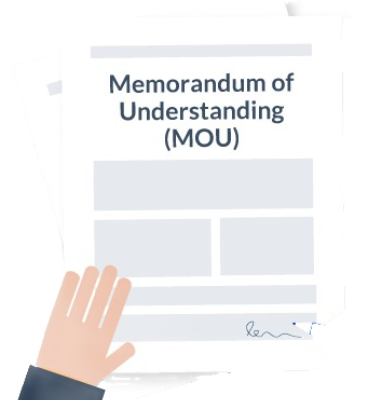
Before signing a formal contract agreement, parties often draw up a memorandum of understanding as a preliminary document. It sets the tone for their relationship and signals that a contract is coming soon. Construction MOUs are often used to begin the relationship between contractors prior to issuing a formalized contract.
We’re going to look at what an MOU is, whether it’s legally binding, how to use one in construction, and what needs to be included in the memo. Finally, we have a free template for you to use to draw up your own memo of understanding for a construction project.
What is a memorandum of understanding (MOU)?
A memorandum of understanding (MOU), often called a letter of intent or notice to proceed, is a nonbinding agreement between two parties that signals their intent to enter into a contract. The memo serves as a starting point for contract negotiations, defining the scope and purpose of the relationship.
An MOU is less formal than a contract and doesn’t contain all the terms of the agreement between the parties. It helps the parties understand what the most important terms and conditions are for the other side and helps them come to an agreement. It also helps resolve conflicts that might occur before the formal contract is signed.

“MOUs are often used to get a construction project started when contract negotiations are expected to take a while,” says Alex Benarroche, a construction lawyer based in Louisiana. “They can expedite the start of the work, which is helpful when dealing with entities that have a complicated contract process.”
“Think of an MOU as someone taking notes while hashing out the details before entering into a contract,” Benarroche says. “Expectations are all laid out and exchanged back and forth between the parties to ensure they’re on the same page, or make any changes before fully binding themselves to a contract agreement.”
Is an MOU legally binding?
Unless the memorandum contains language that says it is a legally binding document, an MOU is not a legal contract. It only focuses on the most important terms and conditions of an agreement and typically won’t cover all the terms that a contract does.
A construction MOU signals that a contract is imminent, but the parties are not legally bound to the agreement. At any time after the memo is signed either party could decide not to enter into a contract and there would be no legal recourse for the other party.
However, don’t assume that a memorandum is non-binding by default. “There are some circumstances where an MOU may be enforced as a contract,” Benarroche says. “For example, if it has all the essential elements of a contract, and is signed with the intention to exchange payment.”
Related: What’s the difference between an estimate, a proposal, and a contract?
An MOU may include language that states it is a legally binding document if both parties agree to such terms. In this case, if one of the parties walked away from the agreement, they could be held legally liable.
How to use an MOU in construction
In construction, MOUs are used to signal the imminent award of a contract to a party. These agreements may be drawn up between the general contractor and project owner or a general contractor and subcontractor.
Often, when the timeline is tight, you may be under pressure to sign off on the contract from both your customer and your sales team. In these cases, an MOU can be used as a sort of placeholder agreement, typically a one or two-page document that defines the general terms while you work out the specifics of the final contract later.

“For whatever reason, contracts are always on fire. It’s always ‘we need it tomorrow,’” says Jonathan Forester, a construction attorney with Riess LeMieux in New Orleans. “Pump the brakes. We have to have an agreement before work can be performed.”
“Where there really is a time-sensitive issue, [we’ve done] a quick 1-2 page memorandum of understanding, saying ‘These are the general terms…we’re going to enter into a formal contract in the next couple of weeks.’ You have something in writing to protect you,” Forester says.
The first step of drafting an MOU is to start negotiating terms by having each party draft their own version of the memo. Each party should include preferred terms that they want included in the agreement, as well as any that are non-negotiable. Many subcontractors include their terms on their proposal, and that language can be used as the basis for an agreement.
“For whatever reason, contracts are always on fire. It’s always ‘we need it tomorrow.'”
Jonathan Forester, construction attorney
Once the parties have reviewed the other’s MOU draft, negotiations can begin on any areas of disagreement. Once both parties have agreed to the terms, then a collective MOU is drafted and signed by everyone.
After the construction MOU has been signed, the parties can then move to formal contract negotiations as necessary. Meanwhile, the contractor or subcontractors can begin work to prepare for the project. Subcontractors often rely on an MOU to start the process of procuring materials for a project, especially when materials have a long lead time. But because the MOU isn’t binding, it’s not necessarily a green light to mobilize and order materials.
“Ordering materials before executing a contract wouldn’t be a smart move,” says Alex Benarroche. “However, if you purchase materials under a reasonable expectation that a contract is ready to be formed, there could be a detrimental reliance claim, depending on the specifics of the case.”
What to include in a memorandum of understanding
Construction MOUs are fairly informal in their style and language, but there are some key pieces of information that should be included in each agreement.
- Parties to the agreement and their contact information
- Effective date of the agreement
- Purpose of the agreement
- Project information and description
- Details of the scope of work and/or contract value (if agreed)
- Roles and responsibilities for both parties
- Conditions of alteration or termination of the agreement
- Dispute resolution options
- Signatures from all parties
We’ve included a template you can use to create your own memorandum of understanding for a construction project.
Download a free construction MOU template

Download a free memorandum of understanding template in either PDF or Google Doc format to use for your own business.
Note: These templates are provided for informational purposes only, and should not be construed as legal advice or guidance. Consult with a construction lawyer before signing any legal document.
An MOU is not a construction contract
MOUs are often the first step in the contract process for a construction project. The owner or general contractor may use them to get the ball rolling and signal that a formalized contract is on the way. But MOUs are not usually legally binding unless they contain language that says differently. They help the parties clearly describe the roles and responsibilities of their relationship and come to an agreement on how they will interact until a contract can be signed.
MOUs are not a substitute for a contract. They allow the parties to come to an agreement on key terms before contract negotiations begin.
